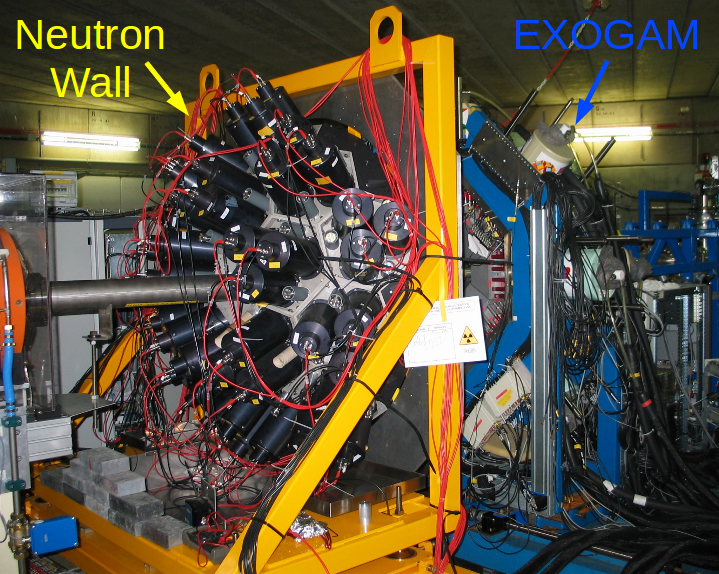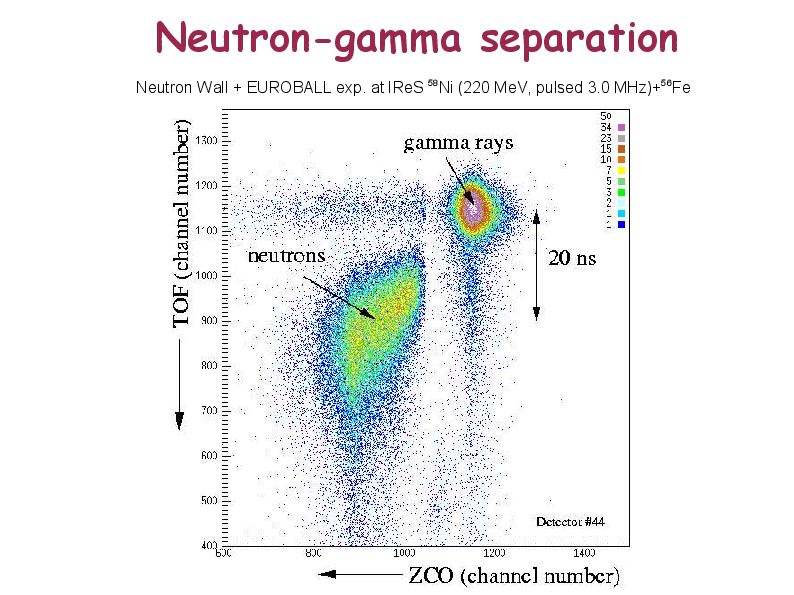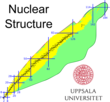Brief Description of the Neutron Wall
 Neutron Wall and EXOGAM at GANIL. Photograph by J. Nyberg (2005-07-15).
Neutron Wall and EXOGAM at GANIL. Photograph by J. Nyberg (2005-07-15).The Neutron Wall is a neutron detector array consisting of 50 closely packed liquid scintillator detectors. It covers a solid angle of about 1π and can be placed in the forward hemisphere of a gamma-ray spectrometer, for example EUROBALL, EXOGAM or AGATA. Together with a light charged particle detector array, for example EUCLIDES or DIAMANT, the Neutron Wall and the gamma-ray spectrometer form a very efficient experimental set-up for studies of the structure of exotic proton-rich nuclei. The task of the Neutron Wall is to select and identify very weakly populated reaction channels associated with neutron emission, by efficiently detecting the neutrons from the fusion-evaporation reactions, induced by stable or radioactive heavy-ion beams.
 Neutron Wall detector types. Photograph by J. Nyberg (2001).
Neutron Wall detector types. Photograph by J. Nyberg (2001).The Neutron Wall array consists of 1 pentagonal and 15 hexagonal detectors. The hexagonal detectors, which are of two different types (H1 and H2), are sub-divided into 3 detector segments, while the pentagonal detector (P) is sub-divided into 5 segments, making a total of 50 segments. Each segment is filled with a liquid scintillator of type BC501A (3.2 litre in the hexagonal and 1.1 litre in the pentagonal segments) and has its own photo-multiplier tube of model Photonis XP4512PA and XP4312B for the hexagonal and pentagonal detectors, respectively. The total liquid scintillator volume is about 150 litre. The detectors are mounted in a closely packed configuration forming a pseudo-spherical shell, which covers about 1π of the solid angle. The distance from the target to the front of neutron detectors is 51 cm and the distance from the front side to the back side of the liquid in the detector segments is 15 cm.
 ZCO vs TOF. Figure by M. Palacz and J. Nyberg, (~2000).
ZCO vs TOF. Figure by M. Palacz and J. Nyberg, (~2000).
The neutron-gamma discrimination is done by combining pulse-shape analysis, based on the zero-cross-over (ZCO) time method, and the difference between the time-of-flight (TOF) of gamma rays and neutrons from the target to the detectors. For each event, the ZCO and TOF parameters, as well as the charge integrated anode signal, called the QVC parameter, are digitised and read out for all neutron detectors which have registered a signal above the selected CFD threshold. Fast (within 300 ns from the CFD signal created by prompt gamma rays) analog (50 mV/hit) and logic (fast NIM) "multiplicity" signals, with information on the number of detected neutrons and gamma rays per event, can be generated and used for triggering purposes. The ZCO, TOF and QVC parameters are generated in dedicated NIM electronics modules (NDE202), which were designed and built for the Neutron Wall by M. Moszynski, D. Wolski et al., at the Soltan Institute for Nuclear Studies in Poland.
In a fusion-evaporation reaction with roughly equal mass numbers of the target and projectile nuclei, the one neutron (1n) detection efficiency of the Neutron Wall is 20-30%. After discrimination of scattered neutrons, the efficiency to detect two neutrons is 1-3%.
For technical descriptions of the Neutron Wall, see the following references:
